Contents
- What is blackberry
- Description of the plant:
- Blackberry composition
- Calorie content of blackberry
- Blackberry varieties
- Some more varieties
- Planting blackberries
- Time to plant
- Blackberry care
- Harvest tips
- Blackberry propagation
- How to choose a blackberry
- How to store blackberries
- Storing in refregerator
- Useful properties of blackberries
- Blackberries during pregnancy
- Blackberry harm
- Blackberries and beekeeping
- Blackberry recipes
- Conclusion
Blackberries are considered to be one of the healthiest berries. In addition to its unique healing properties, it has an excellent taste, which is why people add it to sauces, baked goods, meat dishes, and desserts. However, getting properly ripe berries is not easy because the plant has a special growth and planting algorithm. Consider what blackberries are, the benefits and harms of berries, how to plant and care for them, as well as several useful recipes for all occasions.

What is blackberry
Again, blackberry is a berry, a subgenus of the genus Rubus, the Pink family. Outwardly similar to the genus of raspberries. Differs in rich black or dark red—a place of origin – America. Blackberries have a sweet taste, juicy with a pleasant aroma. It begins to bloom in spring. It is widely used in cooking and has many useful properties. People make delicious honey from this berry.
Description of the plant:
- Semi-shrub. Length 2-5 m.
- Develops within two years. During the first year, shoots grow, buds are forming, and in the second – fruiting. Repaired varieties bear fruit in the first year.
- The stem is green and covered with thorns. Considering the variety of berries, it may have a purple hue.
- Straight shots, strong growth. In the wild, they are not picky about conditions.
- Young sprouts are light green. The leaves are dark, with 3, 5, or 7 leaves.
- Flowering begins in June. The flowers are large and have several petals. The color is white or light pink with green sepals.
- The fruits are polystyrene that grows together. In simple terms, they are called berries. The color is purple, black, red, white, dark yellow. A bluish bloom may be present. The pulp inside after-ripening is juicy, soft. The characteristic taste is sweet and sour.
- Planting should be done using annual seedlings that have formed root soil. Reproduction is carried out through seeds, root processes, and cuttings.
Most people know about this berry only because of its juicy taste and unusual color. But blackberries have many health benefits and make a great addition to your garden.
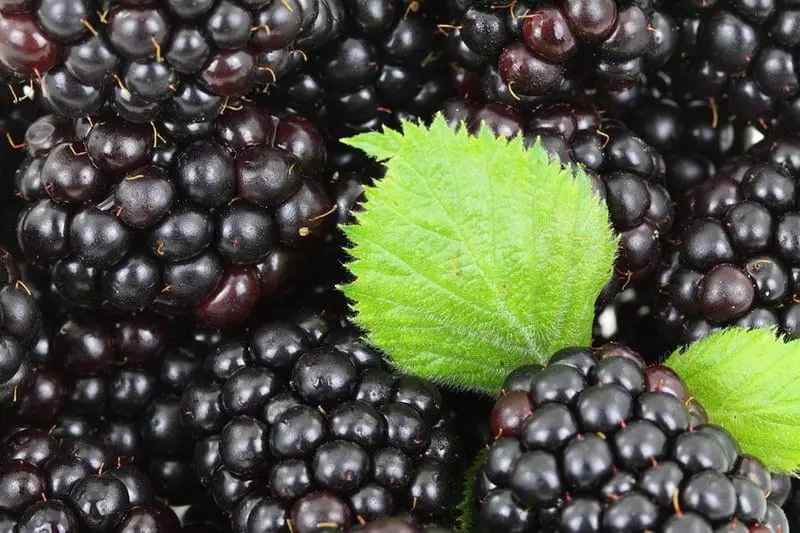
Blackberry composition
Chemical composition:
- potassium;
- magnesium;
- calcium;
- manganese;
- copper;
- vitamins C, K, B6, B2, B1, B4, A;
- sodium;
- phosphorus;
- zinc;
- iron
- selenium.
Thanks to this composition, the product is therapeutic and beneficial for the body.
Calorie content of blackberry
Calculation of nutritional value per 100 g of berries:
- calorie content of blackberries – 43 kcal;
- proteins – 1.4 g;
- carbohydrates – 4.3 g;
- fats – 0.5 g.
Finally, given this information, we can conclude that blackberries are a low-calorie product.
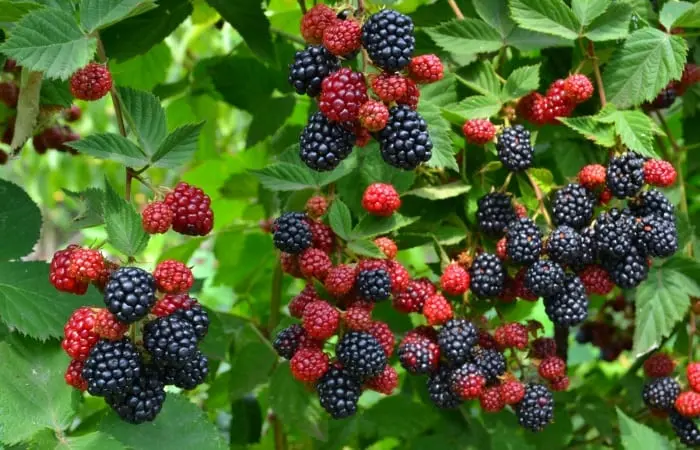
Blackberry varieties
First of all, people conventionally divide the plant depending on the structure of the bush:
- Kumaniki. They resemble raspberries. The stems are prickly and need support. Propagated by root suckers. High resistance to frost.
- Rosyaniki. The characteristic creeping shoots resemble a wild berry. There are varieties with and without thorns. The cultivation is carried out on trellises. Propagated by dropping shoots. It has low frost resistance. Thus you will need a reliable shelter for the winter.
Blackberries have a two-year development cycle. The variety for planting should be chosen, taking into account the regional climate.
Frost-resistant varieties and a short description:
- Agave. An old berry variety that is always in demand. Up to 10 kg of the harvest is possible to take from one bush. The weight of one berry is about 5 g. Sweet and juicy, fully ripe by mid-August. The duration of fruiting is 15 years. They can withstand frosts down to -40 degrees, so no shelter is necessary for the winter. Grows in the shade and sun.
- Polar. A common garden species without thorns. Differs in large, early fruits. From a bush, 5-6 kg of yield. Blackberries weigh about 10 g. Sweet and begin to ripen in early July. Withstand frosts down to -30 degrees. Stems are straight, up to 2.5 m. It would help if you planted it in a sunny place.
- Natchez. Early maturing and large-fruited variety. Each shrub can be harvest up to 20 kg. One berry weighs 10-12 g. Very sweet and ripens in mid-June. They bear fruit in 30-40 days. Shoots are long – up to 3 meters. For the winter, it is necessary to cover with agro fiber. When planting, the distance between the bushes should be at least 2 m.
- Ouachita. The fruits are large – 7-8 g. One bush yields up to 30 kg. The taste is original, intense. The berry ripens in June. Fruiting lasts 2 months. Grown on a trellis. The plant is resistant to pests and diseases. Withstands frosts up to – 10 degrees.
- Chester. An old and popular variety of large-fruited blackberries. The shrub will give birth to up to 20 kg of harvest. The berries are sweet and sour, weighing 5-8 g. Ripening begins at the end of July. The shelter will be necessary for the winter. It’s not good for planting in the shade and damp areas.
Additional varieties
- Black Satin. The ripening period is average—productivity from one bush – up to 15 kg. Berries weigh 5-6 g, with large seeds. The taste is sweet and sour. Ripen at the end of July. The stems are tough. Withstands frosts down to -22ºС.
- Loch Tei. Large-fruited variety, cold-resistant. Average ripening period. Each bush bears fruit up to 12 kg of yield. Berries weighing 5-7 g. Taste sweet and sour, similar to wild. Ripening begins in July. Shoots are about 5 m long, so you need trellises.
Some more varieties
- Kiova. The variety that has the largest berries. Productivity is more than 30 kg from each bush. The mass of one berry is 25 g. These are huge and sweet fruits. The height of the shoots is up to 2 meters; they need support. Withstands frosts down to -23 degrees.
- Columbia Star. A new variety without thorns, usually having early ripening. The berries are long in shape, weighing up to 15 g. Ripening begins in June. Creeping bushes shoot up to 5 m. Withstand frosts down to -14 degrees so that shelter may be necessary. For a long time, the fruits retain their appearance.
- Chachanska Bestrna. The ripening period starts early. Productivity from one shrub is up to 15 kg. The berries are tasty, sweet, and sour, weighing up to 14 g. Ripening begins in June. It shoots up to 3.5 m long and needs support—Frost resistance – up to 26º.
- Doyle. One of the best varieties. Differs in the highest yield—about 7 buckets of harvest, possible to harvest it from one bush. The berry weighs 10 g. The taste is sweet and sour, original. Ripen in mid-August. Shrubs are straight, the length of the shoots is up to 6 m. The trellis will be needed. Easy to tolerate drought.
And another four
- Valdo. The ripening period is average. One bush can harvest up to 17 kg. The weight of one berry is 6-7 g. The taste is pleasant, sweet. Ripen in July. The length of the shoots is no higher than 2 m, so no support is necessary. Average frost resistance a shelter for the winter is required.
- Loch Ness. Late ripening – mid-August. Productivity is up to 25 kg per bush. The fruits are sweet, with a characteristic sourness. Weight up to 8 g. Stems grow up to 4 m, so support is necessary.
- Oregon Thornless. Creeping blackberry variety, late-ripening. Average yield – up to 10 kg per bush. The taste is sweet and sour—large up to 8 g. Shoots 4 m long. The trellis will be necessary to use for the cultivation. Withstands frost down to -30 degrees. It’s good to use for garden design.
- Osage. The most delicious and perennial variety. Low yield – up to 3 kg per bush—weight up to 7 g. Ripening begins in July. Frost resistance up to -13º, you need a shelter. Dessert tastes very sweet. Does not cause soreness.
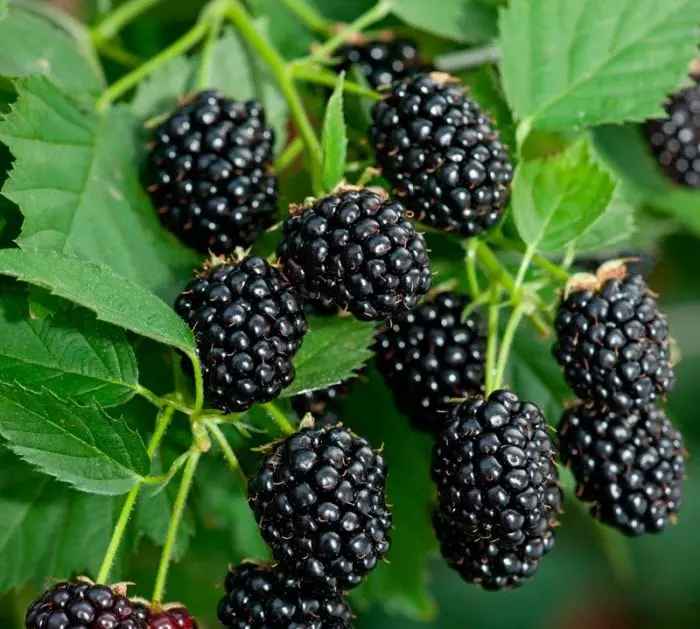
Repaired varieties:
- Freedom. Has no thorns. The harvest is high. Berries are large up to 20 g. Ripening begins in mid-June. Second ripening in August. Stems are up to 2 m; no support needed. The shelter will be necessary for the winter.
- Black Magic. Stems with thorns. One bush can be harvested from 5 kg of the crop. The taste is sweet, the weight of one berry is up to 10 g. Ripen at the end of June.
- Ruben. Repaired variety with large fruits. The stems have spines. Productivity from 5-6 kg per bush. The taste is sweet, pleasant. The average weight of the berries is about 10 g. Ripening begins at the end of August.
In conclusion, this information will help gardeners choose the variety of blackberries to plant in a specific region.
Planting blackberries
Before growing blackberries, you should study this process. The seedlings are planted following the climatic conditions of a particular region. In the north and west of the country, planting is best done in the spring. During this period, planting is carried out until the appearance of the kidneys. It would help if you used annual seedlings, which have a sufficiently developed root system. They have one or two stems with a diameter of 0.5 cm.
You must first prepare the soil. Then, you should perform deep seedbed plowing. People plant the seedlings in furrows or pits 30 cm deep. The roots may go in different directions, and then you need to cover them with earth so that the base of the stem is several centimeters below the surface of the main site. The soil around is requiring plenty of water – about 6 liters per plant. Then it would help if you mulched the holes with peat or manure. If the weather is dry during this period, you should often perform the watering so that the soil is always wet.
Time to plant
Growing berries is difficult, so that inexperienced gardeners may have many questions. But the fruits are very healthy and tasty and are worth your attention. The optimal planting is in open soil in the spring, April-May. Autumn planting is not efficient. Blackberries thrive in sunny places, sheltered from the wind – it can damage fruits and foliage. As a result, this will negatively affect pollination.
Site selection is essential. Firstly, an uneven area on the west or south side is suitable for planting. Secondly, this will help protect the shrubbery from east and north winds. The soil can be sandy loam, but it is better to choose an air-permeable, drained, nutrient-rich soil. Soil acidity – pH 6. Planting on calcareous soil will cause a deficiency of magnesium and iron for the bush. The width between the bushes is 2-2.5 m.
Before planting, you should start preparing the soil in the fall. Remove the weeds from the soil, destroy pathogenic microorganisms, and treat the pests. If the garden soil is regularly processed with approvals, it is not needed specifically to plant blackberries. Otherwise, the plant begins active foliage growth. This adversely affects fruiting.
Blackberry care
Accordingly, in the garden, you should regularly water these berries, loosen the earth’s surface, remove weeds, prune, and fertilize. For the prevention of diseases and pests, could you treat them with special preparations?
Trellises are better for installing in the spring. Then, with the help of twine, fruit-bearing stems are tied to them. Young shoots do not need a garter. They are easy enough to guide. But it is important to monitor this constantly. Otherwise, chaotic growth will occur.
Straight-growing varieties do not bear fruit in the first year. To get fruit in a year, it is necessary to prune the tops by about 10 cm. Watering in the first 2 months after planting should be regular, especially during drought. The water can be tap or rainwater. It is strictly forbidden to use well water. The water is previously exposed to the sun for several days.
Harvest tips
You can get a rich harvest only with constant soil care. It is better to plant row crops between the bushes. Weed as soon as weeds appear. Loosen the soil between the rows 5-6 times a year, up to 12 cm deep. Loosen the soil around the bush with a pitchfork to a depth of 8 cm, 2-3 times during the growing season. You may also reduce the weeding if the loose soil is covered with dry leaves or sawdust.
During the ripening period of berries, the shrub must have a shade from the sun’s rays. Berries scorched by the sun lose their presentation, and their quality decreases. For this purpose, you can use a special shading mesh.
Blackberry propagation
The plant can be propagated in spring, winter, or summer. For bush use basal offspring, cuttings or dividing the bush, for creeping – horizontal, apical layers.
- Reproduction by apical shoots. In the spring, select a weaving stem and bent it to the soil. The top is instilled with a small amount of soil. After a short period of time, roots appear, and new shoots sprout from the soil. Then separate them from the parent bush. This method is considered to be the simplest.
- Reproduction by horizontal layers. The shoots are bent to the soil surface. They are covered with soil along their entire length. As a result, several bushes grow. When this happens, the shoot is cut between them. Young stems are ready for transplantation to a permanent location. Recommended for use in spring.
- Reproduction by root suckers. Shrub plants are easiest to propagate this way. The offspring grow every year near the bush. But only those that have a height of more than 10 cm can be used for transplantation. It is better to do this business in May or June.
Other methods of reproduction are also good to use: cutting roots, seeds, air layers. But they are not very effective and difficult. Therefore, you should use the methods above.
How to choose a blackberry
In the process of buying berries, you should pay attention to the following points:
- The fruits are dark, dry, hard. This is a sign that they are ripe but not overripe.
- Ponytails should not be present. Otherwise, the berries are too early, and they did not have time to absorb all the necessary vitamins.
- The scent should be light and pleasant. If it smells sour, this is a sign that the food is spoiling.
- The berries should be about the same size.
- The containers for blackberries are clean, free from dirt and stains.
- You cannot buy fruits if they have mold.
For tasty berries to be savored for a long time, they must be stored in the refrigerator after purchase. It would help if you washed them only before use.
How to store blackberries
This type of berry is very juicy and soft. Fresh berries can live in the refrigerator for up to 4 days. It may take longer, but they will lose their shape and begin to become moldy. To store in the refrigerator, you should follow these recommendations:
- do not wash the berries;
- place fruits in a storage container in one layer;
- place a napkin at the bottom of the container or tray to get rid of excess moisture.
If the container is locating in the refrigerator, where the temperature is not higher than 0 degrees, then the berry can be left there for about a week. Mashed blackberries with sugar can be stored for up to 3 weeks, and at the same time, they will retain their taste and useful properties.
It is important to consider that if you pick unripe berries, they will remain so. Therefore, you should select only ripe fruits. Rules for preparing blackberries for storage:
- clean from branches, leaves, insects;
- select berries with signs of mold and too soft;
- cut off the ponytails;
- spread out on a paper towel to dry.
Freezing and drying
The fruits can be frozen or dried, are good to use for conservation. Freezing remains the best option. In this way, you can preserve the healing product and its properties. To do this, use two methods:
- Fast freezing. Layout The berries on a clean surface in one layer. Transfer to a serving or cutting board and place in the freezer. After an hour, pour the product into special containers or bags. In this way, the berries do not stick together, and it is easy to pour the relevant amount.
- Storage without pre-freezing. Arrange the berries in small sealed bags. But in the future, you will have to defrost the entire bag to get the berries.
The product can be safe in the freezer for about a year. Another option for storing berries is complete drying. For this, only ripe fruits are used. They are pre-dried in the sun for three days. The berries are covered with gauze to protect them from debris and insects. After a few days, they are poured onto a baking sheet and dried in the oven at a temperature of 50-60 degrees until completely dry. Oven doors must be open.
Storing in refregerator
Often they prefer to grind blackberries with sugar for storage in the refrigerator. In this way, raspberries are still preserved. Berries do not lose their beneficial properties and trace elements that are contained in their composition. In this case, you can use overripe fruits. But there should be no mold or sour signs on them.
The berries are ground in any way and mixed with sugar in a 1: 1 ratio. Then the finished puree is poured into small clean jars and closed with a lid. The product is stored in the refrigerator for up to 3 weeks.
Useful properties of blackberries
Fruits contain many vitamins and minerals. Such a rich composition makes blackberries not only tasty but also healthy. Regular use normalizes metabolic processes in the body and strengthens the immune system. It has an antioxidant, antipyretic effect. Recommended for use in case of colds and respiratory diseases.
Berries are considered a substitute for aspirin but do not harm the body. Useful in the presence of diseases of the digestive tract. This will help normalize digestion. Used in any form for the prevention of diabetes, urolithiasis.
Juice from fruits and young leaves is useful for tracheitis, bronchitis, sore throat, fever, gynecological diseases, colitis. The juice is used externally as a complex therapy for dermatoses, eczema, trophic ulcers.
Blackberries during pregnancy
It is interesting to know how blackberries are good for women. During pregnancy, the body has excessive stress. Therefore, it is necessary to ensure the daily intake of vitamins and nutrients. Blackberries help prevent the occurrence of vitamin deficiency, increase immunity.
Moreover, regular consumption improves memory, normalizes blood circulation, and prevents the development of iron deficiency anemia. Unripe berries are good for constipation, and ripe berries for diarrhea. Blackberry’s beneficial properties will help prevent toxicosis in the early stages.
Blackberry harm
Berries have no contraindications since they cannot be harmful to health. Secondly, in sporadic cases, an allergic reaction to blackberries occurs. Therefore, you should consume the berry should in moderation.
Blackberries and beekeeping
Blackberry bloom begins to bear honey in early June to September. Firstly, the term depends on the variety of berries and climatic conditions in which the shrubs grow. Basically, the honey period lasts 1.5 months. Finally, to obtain a high honey yield, it is necessary to form a different fruit and berry composition.
During the flowering period, the bushes are white. It also comes in pink. For instance, it contains a large amount of pollen and nectar. Therefore, in fact, for bees, the flowering of the bush attracts attention. Up to 35-37 kg of honey gives one hectare. Thus, this is not the highest figure among fruitful plants. Blackberry honey is very healthy, tasty, and original.
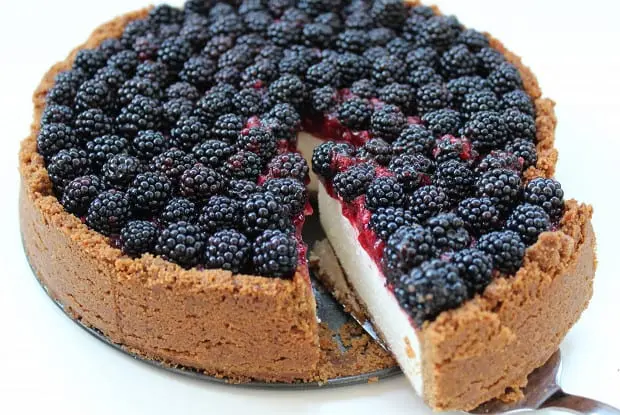
Blackberry recipes
Indeed, the beneficial properties of blackberries allow you to add them to different dishes. Accordingly, the list of popular recipes:
- Biscuit. The easiest baking recipe. Firstly, dry the berries from moisture and sprinkle with powdered sugar. Then they spread it on the bottom of the form and fill them with dough. When ready, turn the biscuit over and, after cooling, sprinkle with powdered sugar.
- Berry sauce. Ingredients: blackberries, red wine, cinnamon, cardamom, cloves, allspice peas, ginger, sugar. Ground and put in a saucepan over a small fire the wine with blackberries. After heating, add spices and keep for another 2-3 m—no need to bring it to a boil. Filter the resulting mixture. The savory sauce is ready. It goes well with meat dishes.
- Fruit salad. Healthy and easy to prepare. Any berries and fruits can be ingredients. Its better to pre-wash and dry berries. Cut them into small pieces and sprinkled with yogurt.
- Ice cream. Beat low-fat yogurt in a blender with blackberries and add sugar. Pour the puree is into molds and place it in the freezer. After that, the ice cream is ready to eat.
- Blackberry jam. 1 kg of berries will need 1 kg of sugar. Boil the jam over low heat for 3-4 hours. This time is enough to turn the berries into a homogeneous mass. Hot poured into cans for preservation. Raspberry-blackberry jam recipes are almost the same.
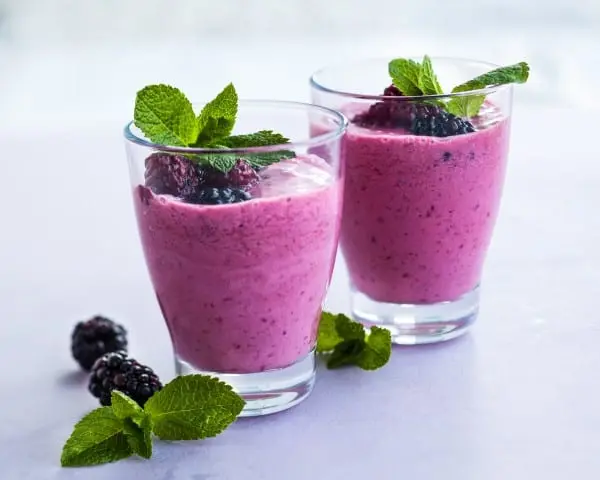
Conclusion
In conclusion, the composition contains a large number of vitamins and minerals. The berry retains its beneficial properties when stored and frozen properly. If you follow all the recommendations, you can plant in your own garden and enjoy high yields.









